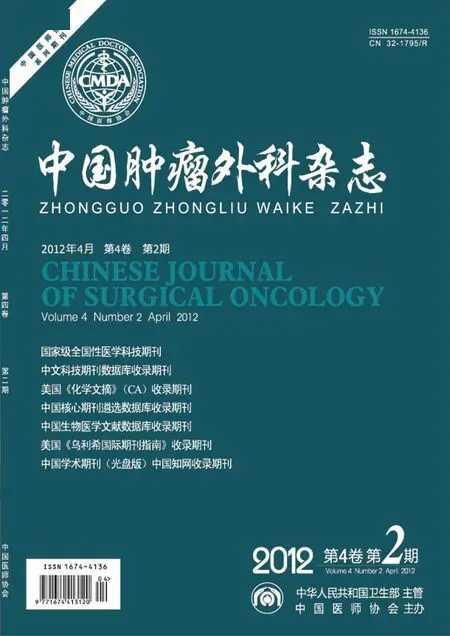新辅助化疗乳腺癌前哨淋巴结活检时机的选择问题
温绍艳, 王 欣, 曹旭晨
前哨淋巴结(sentinel lymph node, SLN)是原发肿瘤淋巴引流的第一个站,是发生淋巴结转移必经的第一站淋巴结。1992年,Morton等[1]证明了在黑色素瘤患者术中应用淋巴造影寻找SLN具有较高的准确性。Kraq等[2]首先将SLNB引入乳腺癌的外科治疗,因其创伤小、并发症少而引起人们广泛关注,之后Albertini等[3]将生物染料法联合放射性核素示踪法应用于乳腺癌SLNB,获得检出率92%、准确率100%的结果,且无假阴性。近十年来许多研究已经证实了SLNB能准确反映腋窝淋巴结状态,并已确定了SLNB在早期乳腺癌中应用的最佳方法[4]。目前,对早期乳腺癌患者手术中以SLNB取代腋窝淋巴结切除术(axillary lymph node dissection,ALND)已经成为标准的治疗模式。
另一方面,新辅助化疗(neoadjuvant chemotherapy,NAC)也越来越多的应用于乳腺癌的治疗。首先NAC提高了乳腺癌患者行保乳手术的可能性;其次NAC是活体的药敏试验,以便选择敏感的化疗方案[5]。近年来,SLNB的适应证逐步扩大,之前有认为NAC是SLNB的禁忌证,但也有许多研究[6-12]报道在NAC前后行SLNB可获得较高的准确性。本文围绕NAC前后行SLNB的可行性以及SLNB的最佳时机进行综述。
1 新辅助化疗前行前哨淋巴结活检
NAC前行SLNB的优点是可以对化疗前ALN状态提供准确的评估,有助于制定新辅助化疗方案和决定是否进行术后局部放射治疗。关于NAC前行SLNB的报道较少[7-8,13]。NAC前SLNB一般适用于原发肿瘤较大但临床诊断无ALN转移的乳腺癌患者。由于(1)NAC可导致淋巴管阻塞或纤维化从而改变淋巴引流路径,因此会影响SLNB的准确性;(2)患者在接受NAC后ALN转移灶可能会被清除,可能增加SLNB的假阴性率。但有两项研究[14-15]表明,SLNB可在NAC前为肿瘤较大的乳腺癌患者提供准确的ALN评估。熟练的操作和丰富的经验可使NAC前SLNB检出率达到100%[7-8,12]。
2 新辅助化疗后行前哨淋巴结活检
NAC后的腋窝淋巴结状态具有非常重要的评估价值[16]。许多研究人员发现,NAC后腋窝淋巴结转阴的乳腺癌患者相较未转阴的患者具有更长的总生存期和无病生存期[17]。因此为了提高生存率,在决定术后辅助治疗方案时NAC后腋窝淋巴结的状态势必成为重要的考虑因素。但考虑到化疗有可能会破坏并改变肿瘤的淋巴引流路径,在NAC后应用SLNB来预测腋窝淋巴结状态仍不被推荐[18]。
目前,许多研究已经证明了乳腺癌患者接受NAC后行SLNB具有很高的可行性和准确性[6,9-10]。运用乳晕旁注射染料的方法,约94%的患者可成功获取SLN,假阴性率为12.1%[19]。有3个meta分析对NAC后行SLNB进行了研究,涉及数千例乳腺癌患者。其中两个meta分析[11-20]的结果支持在NAC后行SLNB,因其具有与未行NAC组结果一致的高检出率和低假阴性率。然而,另一个meta分析[21]得出的结果是NAC后行SLNB的假阴性率是10.5%,而未行NAC组的假阴性率为5%,因此不推荐将NAC后行SLNB作为标准治疗方案。在这些meta分析中,对假阴性率的解释存在差异。早先一些小样本量的研究报道过NAC后行SLNB具有较高的假阴性率,然而目前更多的研究结果显示不存在假阴性率。因为对于临床诊断为淋巴结阴性的NAC后乳腺癌患者,医生在对其行SLNB时需要具有丰富的经验才能得到较高的成功率和较低的假阴性率。Hunt等[9]的研究发现,SLN 的检出率与术者经验密切相关。如将此因素考虑在内,前面3个meta分析的结论是可以接受的,因为在大多数的研究中术者的经验都相对较少。在另一项[22]针对早期乳腺癌患者的meta分析中显示:SLN的检出率为96%,假阴性率为7.3%,这与前面提到的meta分析结果一致。另外,临床诊断为腋窝淋巴结阳性的患者在接受NAC后,其SLNB假阴性率相比腋窝淋巴结阴性患者的SLNB假阴性率高,但无统计学差异[6, 10, 19]。
在NAC后行SLNB的优势之一是可以避免不必要的腋窝淋巴结清扫。有报道称有20%~40%的乳腺癌患者在接受NAC后其ALN会发生降期[23],但降期的患者SLNB假阴性率较高(16.7%)[24]。推测可能的原因是NAC后淋巴结发生降期的同时肿瘤也会因对化疗的反应而缩小,使得肿瘤的淋巴引流路径遭到破坏或改变。此外,如果NAC仅清除了SLN的转移灶,而未清除其他淋巴结中的肿瘤细胞,则会导致假阴性的发生。如果这一问题不能得到解决,前哨淋巴结活检很难常规应用于新辅助化疗后的患者。此外,SLNB假阴性会导致错误的淋巴结分期,以及术后化疗方案的不当选择。而多数针对NAC后SLNB的研究均施行了ALND,故还需针对NAC后SLN阴性却未行ALND的病例进行进一步的研究。
3 新辅助化疗后二次前哨淋巴结活检
对于NAC前SLN阳性的患者在乳腺癌手术中必须行ALND,即便是NAC已经消除了ALN中的肿瘤细胞。Khan等[25]报道了NAC前SLNB阳性的患者二次前哨淋巴结活检情况,研究显示二次活检的检出率为97%,假阴性率为4.5%。Newman等[26]对53例NAC前细针活检或SLNB为阳性的患者,在其NAC后再次行SLNB,结果有 17例(32%)无病灶残留,二次SLNB的检出率和假阴性率分别为98%和8%,与未行NAC患者的检出率和假阴性率一致。ALN转阴的患者其SLNB的准确性非常重要。如果假阴性率可以接受,即便NAC前淋巴结阳性的患者也可以不行ALND。然而如前所述,这部分患者的假阴性率却相对较高。另一方面,目前的研究显示NAC达到CR的患者其SLNB无假阴性。原因可能为这些患者的腋窝转移淋巴结和前哨淋巴结转移灶亦对NAC高度敏感,故极少产生假阴性。近三分之一的SLN阳性患者在二次SLNB中为淋巴结阴性,可避免ALND[25]。虽然二次SLNB弥补了NAC前行SLNB的不足,但是首次SLNB后的淋巴引流改变以及NAC带来的淋巴引流路径改变都会影响二次SLNB的准确性。
4 新辅助化疗后前哨淋巴结活检术中的快速冰冻
虽然此前绝大多数研究中对NAC后SLNB的患者均行腋窝淋巴结清扫术,但是将有越来越多接受NAC的乳腺癌患者通过SLNB结果来决定是否需要行腋窝淋巴结清扫。因此术中SLN情况的判定将变得更加重要,如术中SLN阳性,患者可直接进行ALND。
目前关于乳腺癌NAC后前哨淋巴结活检术中冰冻(frozen-section,FS)病理检查的研究较少[27-28]。尽管NAC会导致淋巴结或转移灶的组织学改变(如纤维化、脂肪坏死、组织细胞蓄积、肉芽组织形成),但是与未接受NAC的乳腺癌患者在SLNB中行FS的结果相比,基本一致。比如Shimazu等[27]比较了接受NAC和未接受NAC乳腺癌患者术中的FS病理结果,发现NAC组SLN冰冻病理检查的敏感性、特异性和准确性分别为74%、100%和88%,而非NAC组分别为71%、99%、90%,结果接近。Rubio等[28]发现,NAC组的FS病理敏感区间在78.5%(微转移或单个肿瘤细胞)到100%(大体转移)之间,与非NAC组的结果无差异。因此我们认为,无论是否行NAC,术中SLN的FS病理结果都十分准确,藉此可使接受NAC的乳腺癌患者避免再次手术带来的痛苦。
5 结语
SLNB对早期乳腺癌患者ALN分期的提示有突出优势,已经成为标准的治疗方式。如果前哨淋巴结阴性则可避免ALND及其带来的术后并发症。SLNB的另一个优势在于让病理医生专注于小标本,给出详细的ALN状况的病理报告。SLNB并非只用于ALN分期,也能使患者避免过度手术。SLNB也为接受NAC的患者带来同样的益处。然而此前多数的研究都未放弃ALND,尤其是NAC后的患者。在SLNB成为NAC的标准治疗前,尚需大量关于前哨淋巴结阴性且未行ALND患者的长期研究。
NAC乳腺癌患者行SLNB的最佳时间仍存在争议,检出率是一个重要的影响因素。Jones 等[29]发现NAC前行SLNB的检出率为100%,而NAC后行SLNB的检出率为81%,最可能的一个原因就是化疗导致肿瘤区域淋巴引流通路的改变。假阴性率是影响最佳时机选择的另一个重要因素,因其可以导致错误的淋巴结分期并导致治疗不足。然而,在NAC前行SLNB患者中假阴性率的提法并不恰当,因为ALND在NAC之后进行,化疗可能改变ALN的状态。因此,NAC前后SLNB假阴性率的比较结果并不能说明问题。此外,第11届St.Gallen专家研讨会上一致认为应在NAC后行SLNB[30]。
综上所述,大量研究和meta分析证明了NAC后行SLNB具有较高的可行性和准确性。但为明确这一结论仍需进一步对NAC后SLNB阴性且未行ALNB的患者进行长期随访研究。虽然几个研究都表明在NAC后行二次SLNB更有保证,但终因样本量少,说服力不足,尚需进行大样本量的临床试验和研究。
[1] Morton DL, Wen DR, Wong JH, et al.Technical details of intraoperative lymphatic mapping for early stage melanoma[J].Arch Surg,1992,127(4):392-399.
[2] Kraq DN, Weaver DL, Alex JC, et al.Surgical resection and radiolocalization of the sentinel lymph node in breast cancer using a gamma probe[J].Surg Oncol,1993,2(6):335-339.
[3] Albertini JJ, Lyman GH, Cox C, et al.Lymphatic mapping and sentinel node biopsy in the patient with breast cancer[J].JAMA,1996,276(22):1818-1822.
[4] Shimazu K, Tamaki Y, Taguchi T, et al.Lymphoscintigraphic visualization of internal mammary nodes with subtumoral injection of radiocolloid in patients with breast cancer[J].Ann Surg,2003,237(3):390-398.
[5] Fisher B, Bryant J, Wolmark N, et al.Effect of preoperative chemotherapy on the outcome of women with operable breast cancer[J].J Clin Oncol,1998,16(8):2672-2685.
[6] Classe JM, Bordes V, Campion L, et al.Sentinel lymph node biopsy after neoadjuvant chemotherapy for advanced breast cancer: results of Ganglion Sentinelle et Chimiotherapie Neoadjuvante, a French prospective multicentric study[J].J Clin Oncol,2009,27(5):726-732.
[7] Kilbride KE, Lee MC, Nees AV, et al.Axillary staging prior to neoadjuvant chemotherapy for breast cancer: predictors of recurrence[J].Ann Surg Oncol,2008,15(11):3252-3258.
[8] Schrenk P, Tausch C, Wolfl S, et al.Sentinel node mapping performed before preoperative chemotherapy may avoid axillary dissection in breast cancer patients with negative or micrometastatic sentinel nodes[J].Am J Surg,2008,196(2):176-183.
[9] Hunt KK, Yi M, Mittendorf EA, et al.Sentinel lymph node surgery after neoadjuvant chemotherapy is accurate and reduces the need for axillary dissection in breast cancer patients[J].Ann Surg,2009,250(4):558-566.
[10] Mamounas EP, Brown A, Anderson S, et al.Sentinel node biopsy after neoadjuvant chemotherapy in breast cancer: results from National Surgical Adjuvant Breast and Bowel Project Protocol B-27[J].J Clin Oncol,2005,23(12):2694-2702.
[11] Xing Y, Foy M, Cox DD, et al.Meta-analysis of sentinel lymph node biopsy after preoperative chemotherapy in patients with breast cancer[J].Br J Surg,2006,93(5):539-546.
[12] Ollila DW, Neuman HB, Sartor C, et al.Lymphatic mapping and sentinel lymphadenectomy prior to neoadjuvant chemotherapy in patients with large breast cancers[J].Am J Surg,2005,190(3):371-375.
[13] Menard JP, Extra JM, Jacquemier J, et al.Sentinel lymphadenectomy for the staging of clinical axillary node-negative breast cancer before neoadjuvant chemotherapy[J].Eur J Surg Oncol,2009,35(9):916-920.
[14] Grube BJ, Christy CJ, Black D, et al.Breast sentinel lymph node dissection before preoperative chemotherapy[J].Arch Surg,2008,143(7):692-700.
[15] Iwase H, Yamamoto Y, Kawasoe T, et al.Advantage of sentinel lymph node biopsy before neoadjuvant chemotherapy in breast cancer treatment[J].Surg Today,2009,39(5):374-380.
[16] Abrial SC, Penault-Llorca F, Delva R, et al.High prognostic significance of residual disease after neoadjuvant chemotherapy: a retrospective study in 710 patients with operable breast cancer[J].Breast Cancer Res Treat,2005,94(3):255-263.
[17] Kuerer HM, Sahin AA, Hunt KK, et al.Incidence and impact of documented eradication of breast cancer axillary lymph node metastases before surgery in patients treated with neoadjuvant chemotherapy[J].Ann Surg,1999,230(1):72-78.
[18] Lyman GH,Giuliano AE,Somerifield MR,et al.American Society of Clinical Oncology guideline recommendations for sentinel lymph node biopsy in early-stage breast cancer[J].J Clin Oncol, 2005,23(30):7703-7720.
[19] Shimazu K, Tamaki Y, Taguchi T, et al.Sentinel lymph node biopsy using periareolar injection of radiocolloid for patients with neoadjuvant chemotherapy-treated breast carcinoma[J].Cancer,2004,100(12):2555-2561.
[20] Kelly AM, Dwamena B, Cronin P, et al.Breast cancer sentinel node identification and classification after neoadjuvant chemotherapy-systematic review and meta analysis[J].Acad Radiol,2009,16(5):551-563.
[21] van Deurzen CH, Vriens BE, Tjan-Heijnen VC, et al.Accuracy of sentinel node biopsy after neoadjuvant chemotherapy in breast cancer patients: a systematic review[J].Eur J Cancer,2009,45(18):3124-3130.
[22] Kim T, Giuliano AE, Lyman GH.Lymphatic mapping and sentinel lymph node biopsy in early-stage breast carcinoma: a metaanalysis[J].Cancer,2006,106(1):4-16.
[23] Kuerer HM, Sahin AA, Hunt KK, et al.Incidence and impact of documented eradication of breast cancer axillary lymph node metastases before surgery in patients treated with neoadjuvant chemotherapy[J].Ann Surg,1999,230(1):72-78.
[24] Shimazu K, Noguchi S.Sentinel lymph node biopsy before versus after neoadjuvant chemotherapy for breast cancer[J].Surg Today,2011,41(3):311-316.
[25] Khan A, Sabel MS, Nees A, et al.Comprehensive axillary evaluation in neoadjuvant chemotherapy patients with ultrasonography and sentinel lymph node biopsy[J].Ann Surg Oncol,2005,12(9):697-704.
[26] Newman EA, Sabel MS, Nees AV, et al.Sentinel lymph node biopsy performed after neoadjuvant chemotherapy is accurate in patients with documented node-positive breast cancer at presentation[J].Ann Surg Oncol,2007,14(10):2946-2952.
[27] Shimazu K, Tamaki Y, Taguchi T, et al.Intraoperative frozen section analysis of sentinel lymph node in breast cancer patients treated with neoadjuvant chemotherapy[J].Ann Surg Oncol,2008,15(6):1717-1722.
[28] Rubio IT, Aznar F, Lirola J, et al.Intraoperative assessment of sentinel lymph nodes after neoadjuvant chemotherapy in patients with breast cancer[J].Ann Surg Oncol,2010,17(1):235-239.
[29] Jones JL, Zabicki K, Christian RL, et al.A comparison of sentinel node biopsy before and after neoadjuvant chemotherapy: timing is important[J].Am J Surg,2005,190(4):517-520.
[30] Goldhirsch A, Ingle JN, Gelber RD, et al.Thresholds for therapies: highlights of the St Gallen International Expert Consensus on the primary therapy of early breast cancer 2009[J].Ann Oncol,2009,20(8):1319-1329.

